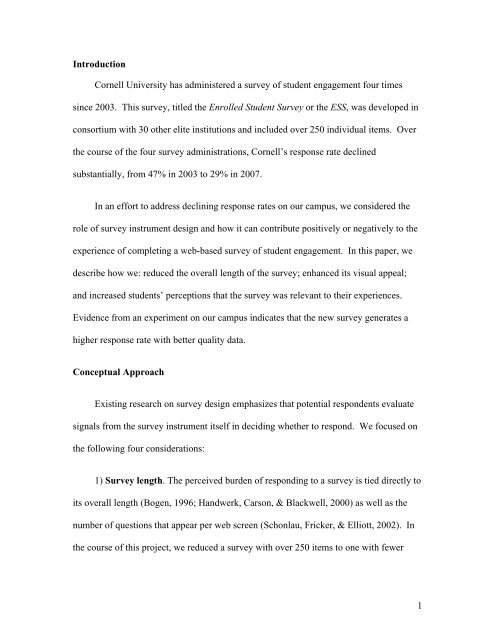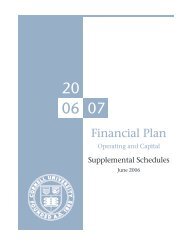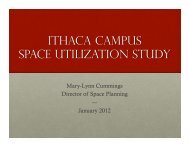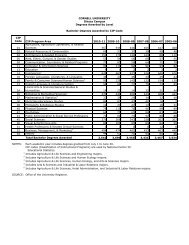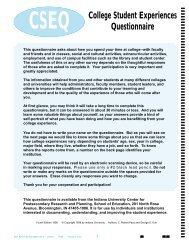Survey Design and Response Rates: - Cornell University Division of ...
Survey Design and Response Rates: - Cornell University Division of ...
Survey Design and Response Rates: - Cornell University Division of ...
You also want an ePaper? Increase the reach of your titles
YUMPU automatically turns print PDFs into web optimized ePapers that Google loves.
Introduction<br />
<strong>Cornell</strong> <strong>University</strong> has administered a survey <strong>of</strong> student engagement four times<br />
since 2003. This survey, titled the Enrolled Student <strong>Survey</strong> or the ESS, was developed in<br />
consortium with 30 other elite institutions <strong>and</strong> included over 250 individual items. Over<br />
the course <strong>of</strong> the four survey administrations, <strong>Cornell</strong>’s response rate declined<br />
substantially, from 47% in 2003 to 29% in 2007.<br />
In an effort to address declining response rates on our campus, we considered the<br />
role <strong>of</strong> survey instrument design <strong>and</strong> how it can contribute positively or negatively to the<br />
experience <strong>of</strong> completing a web-based survey <strong>of</strong> student engagement. In this paper, we<br />
describe how we: reduced the overall length <strong>of</strong> the survey; enhanced its visual appeal;<br />
<strong>and</strong> increased students’ perceptions that the survey was relevant to their experiences.<br />
Evidence from an experiment on our campus indicates that the new survey generates a<br />
higher response rate with better quality data.<br />
Conceptual Approach<br />
Existing research on survey design emphasizes that potential respondents evaluate<br />
signals from the survey instrument itself in deciding whether to respond. We focused on<br />
the following four considerations:<br />
1) <strong>Survey</strong> length. The perceived burden <strong>of</strong> responding to a survey is tied directly to<br />
its overall length (Bogen, 1996; H<strong>and</strong>werk, Carson, & Blackwell, 2000) as well as the<br />
number <strong>of</strong> questions that appear per web screen (Schonlau, Fricker, & Elliott, 2002). In<br />
the course <strong>of</strong> this project, we reduced a survey with over 250 items to one with fewer<br />
1


